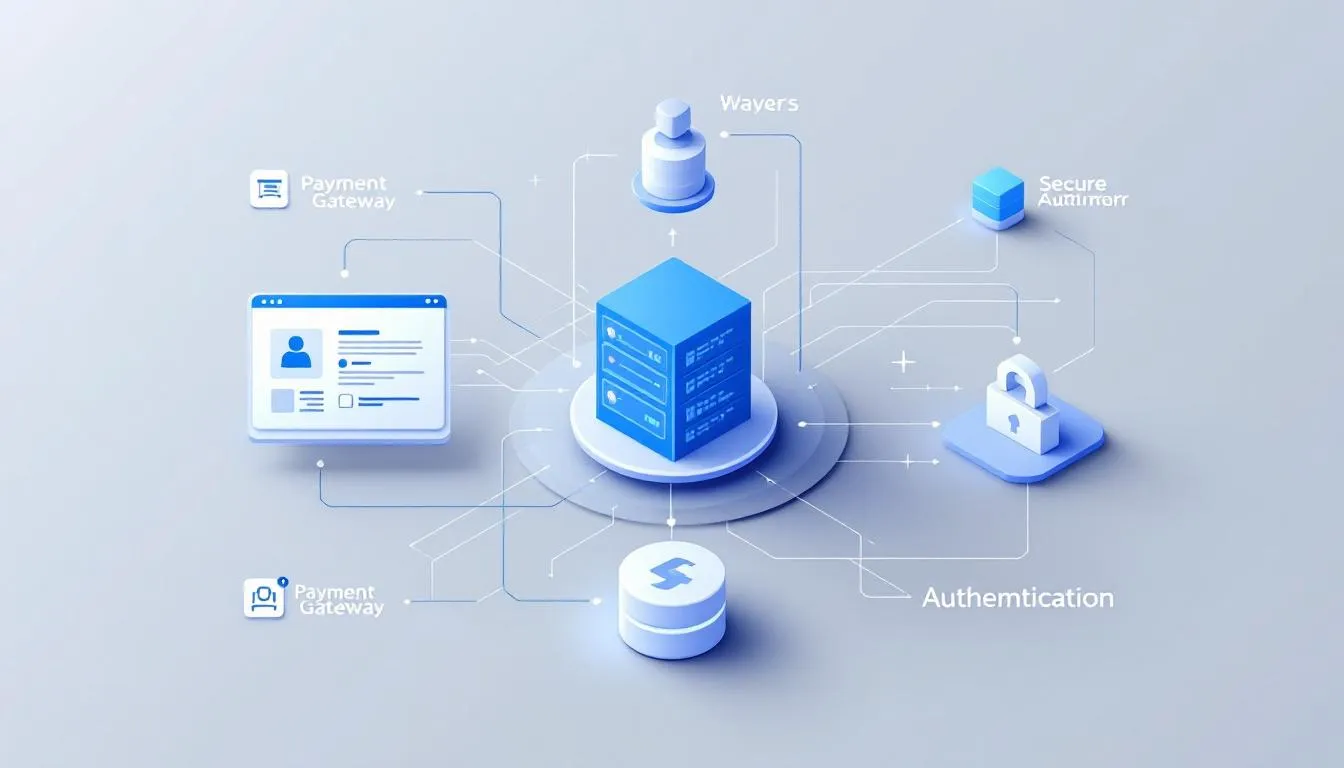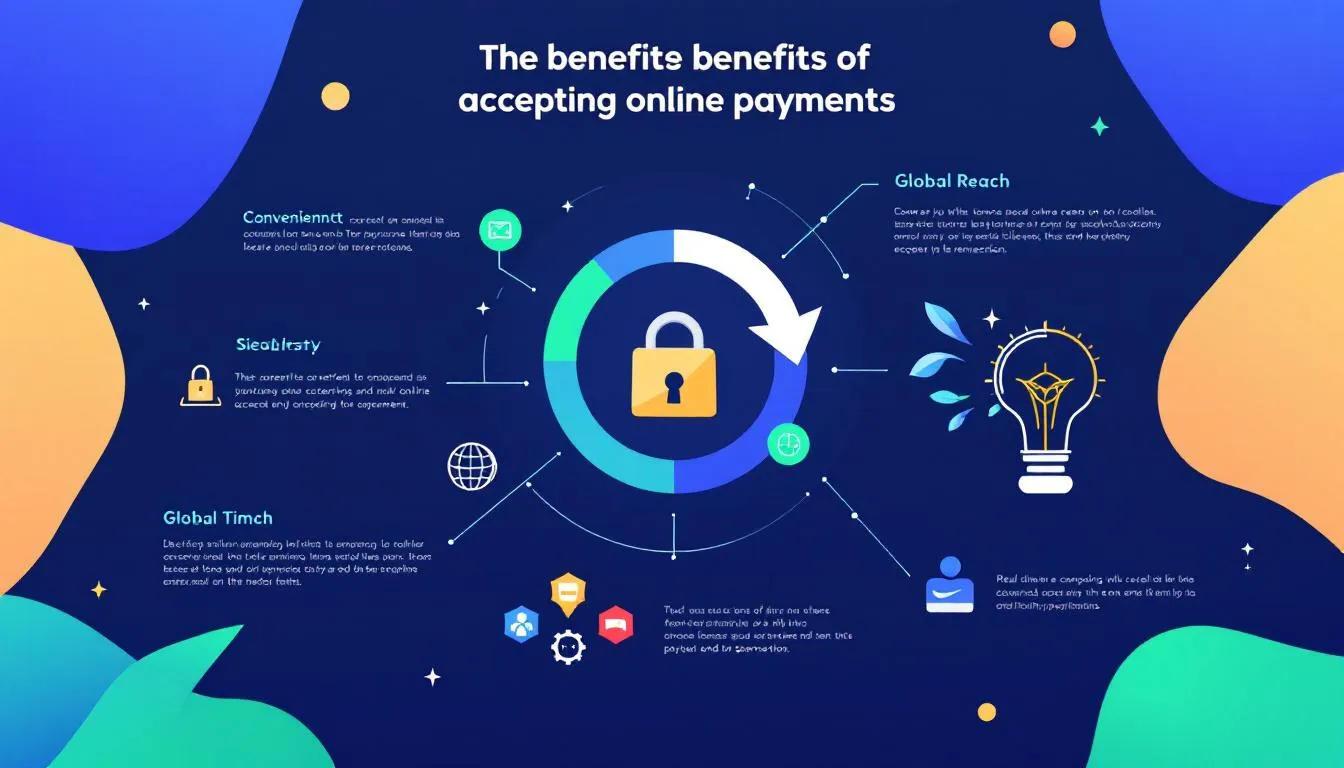Key Takeaways
- Setting up an online payment website requires understanding electronic payment systems, choosing the right payment gateway, and implementing robust security measures.
- Integrating multiple payment methods and offering recurring payment options can enhance the customer experience and reduce cart abandonment.
- Utilizing automated solutions like GoodSolutions.tech can streamline payment processes, improve operational efficiency, and help businesses overcome challenges in managing online payments.
Understanding Online Payment Systems

An online payment system is the backbone of any ecommerce platform. It enables online purchases, deposits, or even mortgages, making transactions smoother and more efficient. These systems consist of software and telecommunication technologies that facilitate cash-free payments, ensuring that both businesses and customers can transact without the need for physical cash.
Electronic payments have become increasingly essential for businesses due to their efficiency and cost-effectiveness. Adopting electronic payment systems allows businesses to enjoy faster, more secure transactions, strengthening relationships with vendors and customers. Additionally, shifting to electronic payments offers improved visibility and control over financial processes, reducing the need for paper and manual processing and resulting in significant cost savings.
There are various payment methods available for online payments, including bank transfers, credit and debit cards, adding payment methods like online card payments, and digital wallets like Google Pay, Apple Pay, Samsung Pay, a payment solution, a payment provider with a payment button, and a payment option.
First-generation payment systems include well-known credit card companies like Mastercard, Visa, and American Express, while second-generation systems, such as PayPal, operate via the Internet with electronic money or even cryptocurrencies. These diverse options cater to different business needs and customer preferences, making it easier to accept payments online and improve the overall customer experience with payment processors.
Essential Components of a Payment Website

Creating a successful payment website requires several critical components. First and foremost, the site must have a clear and user-friendly interface. This ensures that customers can easily navigate through the payment process without confusion or frustration. Additionally, implementing the SSL protocol is crucial for securing user data from fraud during online transactions, providing a safe environment for customers to enter their payment information.
Accepting online payments allows businesses to automate processes, which can significantly enhance productivity by minimizing manual tasks. This automation not only saves time but also reduces the likelihood of errors, ensuring a smoother and more efficient online payment processing experience for both the business and its customers. Many businesses also choose to accept credit to further streamline their transactions, including accepting payments.
Choose the Right Payment Gateway
Choosing the right payment gateway is a pivotal decision for any business looking to accept payments online. A payment gateway acts as an intermediary, processing customer payment information and communicating with financial institutions to finalize transactions. When selecting a payment gateway, it’s essential to consider factors like transaction costs, business requirements, target audience needs, and customer preferences. Typical transaction fees include a fixed fee around $0.30 plus percentage fees that range from 1.4% to 3.5%, including processing fees and payment processing fees.
Different electronic payment methods, including ACH and virtual cards, cater to various business needs and transaction types. The right payment gateway can facilitate transactions and significantly improve the customer experience, making it easier to accept online payments and enhance customer satisfaction.
Popular Payment Gateways
Several popular payment gateways are widely used for facilitating online transactions. PayPal, for instance:
- Allows external account connections
- Provides varying fees based on transaction types and regions
- Offers encryption
- Includes One-Touch checkout features that enhance the user experience.
Stripe is another excellent option, known for its fully customizable checkout process, fraud protection, and support for multiple currencies—ideal for businesses with a diverse international customers base and advanced features.
Square is also a noteworthy mention, especially for businesses that need a comprehensive suite of services including inventory management and analytics, alongside payment processing. Each of these payment gateways offers unique features that can be tailored to meet specific business needs.
Integration Process
Integrating a payment gateway into your website involves several key steps:
- Configure the payment options to ensure they are compatible with your website’s functionality.
- Register on the payment platform’s site.
- Submit an integration application.
- Connect an API to accept various payment methods like digital wallets and credit cards.
Testing the integration is crucial to ensure smooth transaction processing before going live. You can expect constant technical support from payment providers to resolve any integration issues that may arise. This thorough testing process ensures that your payment system works seamlessly, providing a reliable experience for your customers.
Setting Up Your Business Bank Account
Setting up a business bank account is a fundamental step in processing payments online. When choosing a bank, it’s important to compare fees, interest rates, and the benefits each bank offers. To open a business bank account, you typically need a federal Employer Identification Number (EIN), business licenses, and formation documents.
Business accounts often include:
- Checking accounts
- Savings accounts
- Credit card accounts
- Merchant services accounts
Merchant services accounts, in particular, allow businesses to process credit card payments and debit card payments through a merchant account, charging transaction fees based on usage.
Using a business bank account offers limited personal liability protection for a business owner by keeping business and personal funds separate, which is crucial for financial management.
Implementing Security Measures
Security is paramount when dealing with online payments. Payment gateways must comply with PCI-DSS standards to ensure the secure handling of card data, which enhances customer trust and protects businesses from data breaches. Establishing organizational policies supports ongoing information security efforts and is essential for maintaining a secure payment environment.
Key security measures for protecting payment information include:
- Using strong data encryption methods, such as SSL certificates, to protect sensitive payment information during transactions.
- Implementing robust anti-fraud systems to prevent increased failed payments and potential losses.
- Regularly testing systems and networks to identify potential vulnerabilities and ensure the payment system remains secure.
Limiting access to cardholder data based on business necessity and restricting physical access to systems storing this data to authorized personnel only are other important security measures. These practices help safeguard sensitive information and maintain the integrity of your payment system.
Adding Multiple Payment Methods
Offering multiple payment methods can significantly enhance customer loyalty. Shoppers are more likely to return when they can pay conveniently using their preferred payment method. Integrating various payment methods not only improves the overall customer experience by reducing friction during online transactions but also decreases the rate of cart abandonment.
Different demographics prefer different payment methods, so catering to these preferences can expand your customers pay base and simplify the checkout process. Utilizing alternative payment methods can also reduce cart abandonment caused by declined credit card transactions.
Offering a variety of secure payment options helps businesses improve brand perception and achieve higher conversion rates.
Configuring Recurring Payments
Recurring payments are an excellent way to manage subscriptions and predict revenue. Choosing a payment processor that specializes in recurring billing can simplify managing subscriptions and customer accounts. You can set up recurring payments in two main ways. These include building a custom payment system or purchasing existing software.
Tools like Stripe Billing offer an end-to-end billing solution that includes subscription logic and invoice management. Recurring billing can be customized with options like free trials, usage-based fees, and discounts for annual payments, providing flexibility to meet various business needs.
Automating recurring payments ensures a seamless experience for both the business and its customers.
Testing and Simulating Transactions
Before launching your payment system, thorough testing is crucial to identify bugs and errors. Utilizing sandbox environments offers several advantages:
- Allows developers to conduct tests without affecting actual transactions or handling real money.
- Provides additional functionalities, such as multiple environments.
- Offers granular access control, enhancing the testing process.
Testing environments enable the simulate transactions of various payment scenarios using test credit card numbers, which is essential for validating the payment integration. This ensures that your system works smoothly and can handle real-world transactions without any issues, providing a reliable payment experience for your customers.
Launching Your Payment Website

Launching your payment website builder involves several critical steps:
- Ensure all essential pages are set up, including the homepage, about page, and contact page.
- Replace any placeholder content with your unique text and images to maintain professionalism.
- Test all forms and interactive elements to prevent user frustration and ensure proper functionality.
Improving the speed and user-friendliness of payment pages can help decrease the likelihood of shopping cart abandonment. Low conversion rates often stem from transaction difficulties, so optimizing these pages is crucial for a successful launch. Focusing on these elements ensures a smooth and user-friendly experience for customers.
Monitoring and Managing Transactions
Effective monitoring and management of transactions are essential for maintaining a smooth payment process. Key practices include:
- Implementing real-time transaction tracking to help identify and resolve issues quickly.
- Monitoring daily and weekly transaction summaries.
- Watching for errors to gain insights into your payment system’s performance.
From the integrated payment dashboard, you can manage all business transactions, payments, refunds, and chargebacks. Tools like the Chargeback Summary Report allow businesses to monitor their compliance with card associations by providing detailed data on sales, refunds, and chargebacks.
Utilizing a built-in dispute tool on your payment dashboard can help handle chargebacks effectively. By monitoring these aspects, you can ensure a healthy financial status for your business.
Enhancing Customer Experience
Enhancing the customer experience is crucial for retaining and attracting customers. Key methods include:
- Providing real-time updates to keep customers informed and engaged throughout the payment process.
- Using AI-driven chatbots to offer round-the-clock support.
- Allowing instant inquiry routing to enhance customer interactions and satisfaction.
Automated systems can trigger post-service review requests, encouraging customers to share their feedback, which can aid in lead conversion. Utilizing chatbots can lead to an increase in qualified leads by up to 40%, showing how effective customer engagement strategies can improve overall experience.
Leveraging Good Solutions Technology
Leveraging the right technology is critical for automating routine tasks and helping your business grow. GoodSolutions.tech provides an all-in-one tailored solution that automates routine tasks, making it easier for business owners to focus on their core operations. This automation can help convert leads while you sleep, capture more leads overnight, and reduce manual follow-up.
GoodSolutions.tech also offers 24/7 multilingual support with AI-powered chatbots that provide instant and accurate responses, enhancing customer experience. Furthermore, their AI-powered anti-fraud system helps prevent fraudulent activities on the platform, ensuring secure transactions.
By integrating GoodSolutions.tech, businesses can streamline their operations, keep track of customers, create workflows, and ensure all tools work together seamlessly.
Benefits of Accepting Online Payments

Accepting online payments offers numerous benefits for businesses:
- E-commerce can lead to increased sales by aligning with the growing consumer preference for online shopping.
- Businesses can reach a wider audience and accommodate consumers who shop across multiple channels.
- Implementing online payment solutions speeds up the transaction process.
- Streamlining cash flow and enhancing customer satisfaction.
GoodSolutions.tech can simplify the process of implementing online payment solutions, making it easier for businesses to accept payments online and cater to the demand for convenience. Leveraging their technology allows businesses to enjoy the benefits of accepting online payments, including streamlined transactions and enhanced customer experience.
Challenges and Solutions
Setting up an online payment system comes with several challenges:
- High development costs
- Complexity of compliance
- Ongoing maintenance
- Fraud risk
- Technical issues
Retailers often struggle to unify data across online and in-person payments, making it difficult to manage transactions effectively.
GoodSolutions.tech offers solutions to these challenges by providing an all-in-one tailored solution that automates routine tasks and helps prevent fraudulent activities. Their platform also ensures regulatory compliance, making it easier for businesses to navigate the complexities of tax regulations and avoid penalties.
Leveraging GoodSolutions.tech helps businesses overcome online payment challenges and focus on growth.
Summary
Setting up a payment website is an essential step for businesses looking to thrive in the digital age. From understanding online payment systems to implementing advanced security measures, each step is crucial in ensuring a seamless and secure payment experience for customers. By choosing the right payment gateway, offering multiple payment methods, and leveraging GoodSolutions.tech, businesses can enhance their operations and improve customer satisfaction.
Accepting online payments not only streamlines transactions but also opens up new opportunities for growth. As you embark on this journey, remember that the key to success lies in providing a convenient, secure, and efficient payment experience for your customers. With the right tools and strategies, your business can thrive in the digital marketplace.
Frequently Asked Questions
What are the essential components of a payment website?
A user-friendly interface, SSL security for protection, and automated processes are key components for a payment website. These elements work together to ensure a smooth and safe user experience.
How do I choose the right payment gateway?
To choose the right payment gateway, focus on transaction costs, your specific business needs, and what your customers prefer. Popular choices like PayPal, Stripe, and Square are worth considering based on these factors.
What security measures should I implement for online payments?
To ensure safe online payments, focus on PCI-DSS compliance, use strong encryption and SSL certificates, and have anti-fraud systems in place. Regularly testing your systems also helps to maintain security.
What are the benefits of accepting online payments?
Accepting online payments boosts your sales and expands your customer reach, making transactions smoother and enhancing overall satisfaction. It’s a win-win for your business!
How can GoodSolutions.tech help my business with online payments?
GoodSolutions.tech can streamline your online payment process with its automated solutions, multilingual support, and fraud prevention features, helping your business thrive effortlessly. With their tailored approach, you can focus on growth while they handle the complexities of payments.
#PaymentWebsite #OnlinePayments #PaymentGateway #Ecommerce #SecureTransactions #MultiplePaymentMethods #RecurringPayments #BusinessBanking #PCIDSS #FraudPrevention #PaymentAutomation #GoodSolutionsTech #EcommerceTips #OnlineBusiness #PaymentSecurity
